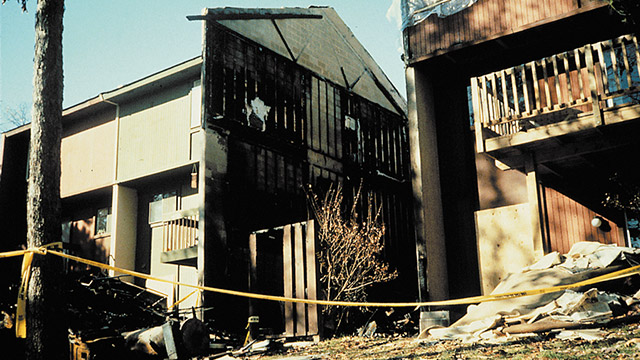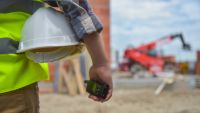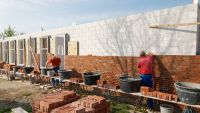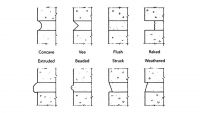Safety through masonry
Code changes that will make buildings and their residents safer
By William Hall
The current cycle of building code hearings began in Memphis, Tenn., in late-April. And, for months, the Masonry Alliance for Code and Standards (MACS) has been working to develop and submit code changes to the building code that increase the level of safety and resilience for the built environment and its residents.
The code proposals that make their way through the code development process will be incorporated and published as the 2018 International Building Codes. Many contractors will likely have anxiety about new codes being adopted within varied jurisdictions. Often, they are are against the change and ambiguity associated with building code updates and adoptions.
Changes to building codes, however, include much more than the details for daily operations, such as the mortar type or foundation bolt spacing, which have been known to change from time to time. Changes to the building code also include philosophy changes relevant to what building codes provide, and what many believe they should provide, regarding performance during and after a natural or manmade disruptive event.
During the last couple of decades, minimal cost and affordability combined with maintaining or improving life safety during fire and other emergency events, have been a big focus and goal in the development of building codes. Residential fire sprinkler systems are now required for all residential occupancies and have been shown to be extremely successful in reducing fire deaths nationwide.
Lightweight wood construction combined with National Fire Protection Association, NFPA 13R – residential sprinkler systems have enjoyed a steady increased market share in low rise multi-family housing for new construction since the mid-1990s. Hourly fire resistance ratings for structural elements, which were once required by code, have been reduced or eliminated based on the presence of a sprinkler system.
The trend to reduce the ratings is based on the philosophy that hourly ratings should not be required to be any higher than it takes for occupants to evacuate the building. Property protection has taken a back seat in the building codes, unless necessary for life safety, as in the example of collapse avoidance during a seismic event when residents do not have time to evacuate. Even then, the performance and continued usability is not guaranteed or even implied by the building code.
Multi-housing developers use every allowable increase, reduction and loophole available by the code to legally build structures as high as seven stories using combustible material. One such structure was seen in Los Angeles on several newscasts, burning to the ground while under construction.
Edgewater, N.J., experienced a similar scenario on Jan. 21 of this year, when an occupied and sprinkled multi-family housing complex caught fire and burned mostly down, displacing more than 500 residents living in the complex and another 500 who were unfortunate enough to live adjacent to the inferno. Surprisingly, this structure had burned down previously, while under construction.
It is not surprising, however, that while fire deaths for civilians have reduced significantly, firefighter deaths and property losses from fire have trended upward during the last 20 years. Fire fighters have often cited lightweight construction as the main cause for early fire collapse and a big concern to firefighter safety.
Another big issue is the fact that sprinklers do sometimes fail to operate, as well as fail to suppress the fire. The National Fire Protection Association (NFPA) reports sprinkler failure rates between 10 percent and 14 percent. Not all sprinkler systems are created equally. And, residential sprinkler systems or NFPA 13R systems do not protect concealed combustible spaces and, in fact, do not require attics or small rooms within living spaces to be sprinkled. In addition, quick response heads, which are used in the design of these systems, do not emit nearly the amount of water as their most robust cousin, NPFA 13. Quick response heads are intended to delay flashover from occurring within the individual dwelling unit or space, while allowing residents additional time to escape. NFPA 13 systems are designed to suppress fire from spreading and require sprinkler protection within attic spaces.
Property losses from storms and other natural events also have been on a sharp rise. After Hurricane Sandy, the federal government paid out $80 billion for rebuilding efforts alone. This, along with countless other disaster relief and funding efforts, including Hurricane Katrina, have caused the federal government as well as state governments to review the building codes and the appropriateness of combustible lightweight construction for multi-family housing.
In New Jersey, a bill has been introduced to issue a moratorium on multi-housing projects using wood construction until this issue can be reviewed. The National Institute of Science and Technology, a federally owned testing and research facility located in Gaithersburg, Md., has been tasked to develop guidelines for states, cities and jurisdictions to use to develop more resiliencies within their communities and infrastructures.
Industry experts nationwide have convened on multiple occasions to develop the document “Guidelines for Community Resilience.” Members of MACS have participated in those meetings and strongly vocalized that the use of non-combustible passive fire protection, in addition to fire sprinklers and early detection, provides a balanced approach to fire protection consistent with more resilient construction.
“Resiliency” has become the new catch phrase within government at all levels, due in part to climate change, flooding, increases in fire damage, costs to rebuild, and the costs to communities from losing residents, businesses and tax base. The taxpayers through the Federal Emergency Management Agency and Homeland Security cannot continue to fund the recovery efforts after storms destroy entire communities.
Building codes must recognize the importance of a building’s ability to continue standing and safely perform its intended function, even after design-level natural disaster or a fire – or both. MACS and its members remain on the front line in these venues and continually push for requirements that incorporate the proven fire safety products produced and used by its members.
Most proponents of wood construction will testify that projects using lightweight wood frame construction are more cost efficient and can be constructed faster and easier than those using concrete and masonry. This has been shown to be a fallacy by research funded by members of MACS and allied cement groups.
Studies conducted by HAAS Architects and Engineers showed concrete and masonry projects at a difference of -3 percent to +3 percent in overall costs of construction, when compared to lightweight wood frame and based on locations across the nation. Upcoming research projects funded by members of MACS are expected to show how resilient construction techniques using non-combustible concrete and masonry products are comparable in cost and time of completion, while inherently providing higher levels of fire protection.
Here’s what you can do: First, you can applaud industry groups for their dedication, participation, and support of MACS. If you are in any way involved in the masonry industry, you have surely benefited from the efforts of MACS. Second, encourage your industry allies to continue to be involved or become more involved MACS.
Originally published in Masonry magazine.
About the Author
William Hall is a Certified Building and Fire Official who works for the Portland Cement Association as Manager of Codes and Standards.
For more information, visit www.cement.org/think-harder-concrete-/codes-standards.



















